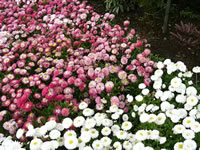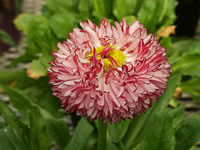How to Grow and Care for English Daisy Plants
Bellis perennis
           
|
The original English Daisy is the wildflower Daisy that is often seen growing in lawns throughout the world.
This rosette forming, low-growing biennial has now been hybridized to include double flowering, aster-like varieties in shades of white, pink, rose-red or purple.
The bright 2" flowers appear in succession, on 6" stems from April through June.
English Daisies are excellent ground covers, border plants or for the rock garden,
as well as for growing in containers or tubs.
Growing Requirements for English Daisies
The English Daisy is a biennial plant that is hardy in USDA zones 4-10.
They prefer cooler climates so they are usually grown as an annual in zones 8-10.
English Daisies should be grown where they will receive full sun in cool regions and light shade in the warmer zones.
|

|
|
Plant English Daisies 6" apart in light, rich, moisture retaining soil after all danger of frost has passed.
Water regularly and thoroughly. English Daisies do no like to dry out!
Feed monthly during the growing season using any good, all-purpose fertilizer.
|
|
Removing faded flowers regularly will help keep plants blooming well into the summer.
Propagating and Growing English Daisies from Seed
English Daisy plants can be divided in early spring or after they've finished flowering.
In mild winter areas, sow seeds in the garden in late summer.
In colder regions, seeds should be sown in early spring.
English Daisy seeds can also be sown indoors.
Maintain a temperature of 70° within the growing medium until germination,
which takes 10-15 days. |
English Daisies
Bellis perennis
 |
 |
 |
|
|
|
Search The Garden Helper:



